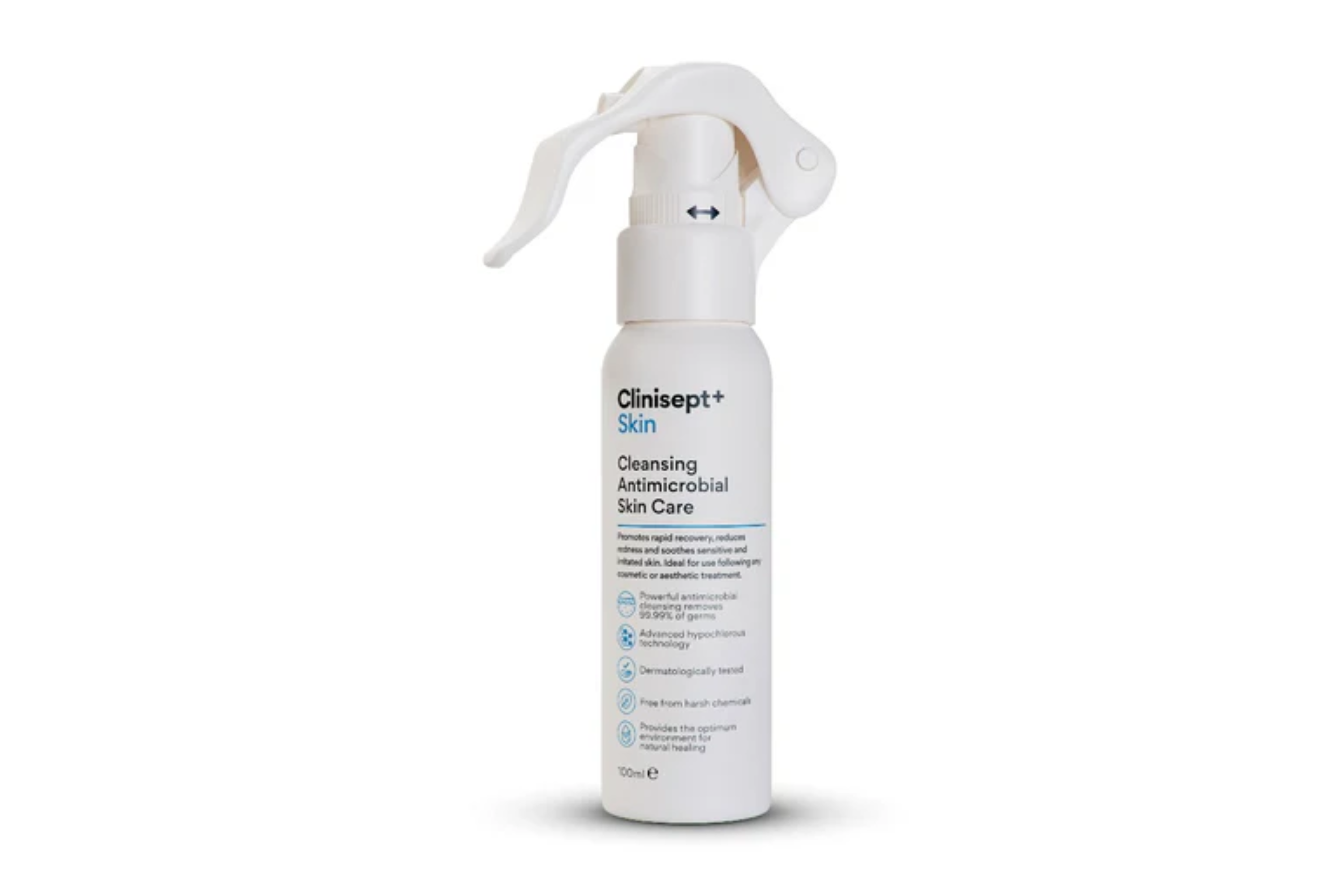Hypochlorous acid is the latest skincare fixation. The lesser-known ingredient is said to tackle the germs and acne that go hand in hand with sweaty scenarios – whether that’s the gym or a stuffy train.
For most, hypochlorous acid came on their radar in 2020. Its disinfectant and virus-killing properties meant that it came to prominence during the coronavirus pandemic. Since then, the solution has gained popularity with TikTok users and celebrities alike. Referring to Clinisept’s hypochlorous spray (£14.95, Facethefuture.co.uk), This Morning’s Rochelle Humes told Grazia, “I have no breakouts when this is part of my routine.”
But what is this hero spray, and do you actually need it? We spoke to skin expert Dr Lauren Jamieson to learn all the ins and outs of the formula, including how often to use it and where it should sit in your routine. Scroll on for her professional insight.
Meet the expert
Dr Lauren Jamieson is a medical doctor who, after qualifying as a GP in 2011, undertook specialised training in the field of aesthetics. She now owns and runs a clinic in Hamilton, offering treatments from microneedling to dermal fillers.
What is hypochlorous acid?
Hypochlorous acid is a “powerful antimicrobial”, explains Dr Jamieson. It’s “a weak acid which the body produces naturally as part of the immune response to infection”, which is also manufactured for topical use.
What is hypochlorous acid made from?
Dr Jamieson explains that hypochlorous acid is “made by passing electricity through salt water”. This process “forms a solution that can be safely used as a disinfectant, effective on a wide spectrum of microbes”.
What are the benefits of hypochlorous acid?
There are lots of benefits to using hypochlorous acid on the skin. “It promotes wound healing and is effective in managing conditions like acne, rosacea and eczema,” explained Dr Jamieson.
Read more: Glycerin is the skincare buzzword you need to know
Is hypochlorous acid helpful for acne?
Owing to its properties, “hypochlorous acid is increasingly accepted and recommended as part of a robust treatment for acne”, explains Dr Jamieson.
Firstly, it kills bacteria, particularly acne-causing bacteria such as cutibacterium acnes, preventing future breakouts. Hypochlorous acid also “calms redness and swelling associated with breakouts”.
On top of that, Dr Jamieson says that the acid “supports healing of broken skin” – so if you tend to pick your spots, hypochlorous acid should speed up recovery.
Crucially, hypochlorous acid is also non-comedogenic, which means “it doesn’t block pores, and it supports a healthy skin barrier function”.
Can you use hypochlorous acid after working out?
“Hypochlorous acid is especially powerful when it comes to exercise, which carries its own set of challenges for skin,” explains Dr Jamieson.
The acid can offer a great way to ease the inflammation that can follow intense activity, she says. Similarly, “bacteria thrive in warm, sweaty environments,” so using hypochlorous acid, which is antimicrobial, is a great way to remove bacteria after exercise.
Much like hormonal or fungal acne, Dr Jamieson says hypochlorous acid can minimise post-workout blemishes, and do so “without drying or irritating skin”.
Finally, it can also soothe redness, “especially if your skin becomes flushed or sensitive after cardio”.
Can you use hypochlorous acid over makeup?
If you’re used to what Dr Jamieson describes as “high bacterial exposure” in crowds or areas of pollution, hypochlorous acid can counteract sweat, grime, and germs. However, she warns that when wearing makeup, “the overall effectiveness might be a little reduced, but its antimicrobial and anti-inflammatory action is the same”.
Can you use hypochlorous acid on underarms?
Hypochlorous acid is a great alternative to deodorant for those with sensitive skin. This is because it “kills odour-causing bacteria, without blocking sweat glands, and reduces inflammation after shaving, as well as preventing ingrown hairs”, explains Dr Jamieson.
Are there any side effects to hypochlorous acid?
“There are few, if any, side effects from using hypochlorous acid.” This acid “doesn’t cause irritation or sting, so it can be safely used around the eyes”.
This also makes it safe for use on broken and irritated skin and, in the case of certain formulations such as Clinisept’s (£12.53, Amazon.co.uk), on skin post-procedure or surgery. It can also be used for “skin cleansing before procedures”, says Dr Jamieson, and, surprisingly, it “even has applications in food sanitation and water purification”.

How to use hypochlorous acid spray
Hypochlorous acid is simple to use and “can be used daily or even twice daily on cleansed skin, allowed to dry, and followed by a regular skincare programme”, says Dr Jamieson. Generally, this means it should be used post-cleanser but before your toner, moisturiser and SPF. Of course, as mentioned previously, it can also be used independently atop makeup or post-workout.
Most hypochlorous sprays are packaged with a spray nozzle, so we’d suggest applying three to five pumps to douse the skin, depending on the amount of liquid dispensed.
Is hypochlorous acid bleach?
While regular hypochlorous acid users might note that the formula has a slight bleachy or chlorine-like odour, Dr Jamieson emphasises that it is “not bleach”. However, she adds that it is “a chlorine-based compound – just one that’s compatible with living tissue.
“When it breaks down naturally or reacts with organic tissue (like skin), it can release small amounts of chlorine or related compounds.” This, she says, is what gives it a slight whiff of swimming pool.
Looking to explore more skincare acids? Why not discover everything you need to know about salicylic acid, according to the experts



